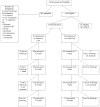Intensive intervention for alcohol-dependent smokers in early recovery: a randomized trial
- PMID: 22014532
- PMCID: PMC3288470
- DOI: 10.1016/j.drugalcdep.2011.09.026
Intensive intervention for alcohol-dependent smokers in early recovery: a randomized trial
Abstract
Introduction: The purpose of this study was to investigate the efficacy of an intensive tobacco cessation intervention for alcohol-dependent smokers in early recovery.
Methods: A total of 162 alcohol-dependent smokers were randomized to either intensive intervention for smoking cessation or usual care. The intensive intervention consisted of 16 sessions of individual cognitive behavior therapy (CBT) and combination nicotine replacement therapy that lasted 26 weeks. Usual care involved referral to a free-standing smoking cessation program that provided smoking cessation counseling of varying duration and guideline-concordant medications. The primary cessation outcome was verified 7-day point prevalence abstinence (PPA) at 12, 26, 38, and 52 weeks.
Results: At 12 and 26 weeks, the verified 7-day point-prevalence quit rate was significantly higher for the intensive intervention group than for the usual care group (both p=0.03). However, the quit rates for the two treatment groups were not significantly different at 38 or 52 weeks. Verified 30-day alcohol abstinence rates were not significantly different for the two treatment groups at any of the follow-up assessments.
Conclusions: The intensive smoking cessation intervention yielded a higher short-term smoking quit rate without jeopardizing sobriety. A chronic care model might facilitate maintenance of smoking cessation during the first year of alcohol treatment and perhaps for longer periods of time. It is hoped that studies such as this will inform the development of more effective interventions for concurrent alcohol and tobacco use disorders.
Published by Elsevier Ireland Ltd.
Conflict of interest statement
There are no disclosures for any authors.
Figures





Similar articles
-
A randomized trial of concurrent versus delayed smoking intervention for patients in alcohol dependence treatment.J Stud Alcohol. 2004 Nov;65(6):681-91. doi: 10.15288/jsa.2004.65.681. J Stud Alcohol. 2004. PMID: 15700504 Clinical Trial.
-
A randomized trial for hazardous drinking and smoking cessation for callers to a quitline.J Consult Clin Psychol. 2015 Jun;83(3):445-54. doi: 10.1037/a0038183. Epub 2014 Nov 24. J Consult Clin Psychol. 2015. PMID: 25419583 Free PMC article. Clinical Trial.
-
Concurrent brief versus intensive smoking intervention during alcohol dependence treatment.Psychol Addict Behav. 2007 Dec;21(4):570-5. doi: 10.1037/0893-164X.21.4.570. Psychol Addict Behav. 2007. PMID: 18072840 Free PMC article. Clinical Trial.
-
Interventions to reduce tobacco use in people experiencing homelessness.Cochrane Database Syst Rev. 2020 Dec 3;12(12):CD013413. doi: 10.1002/14651858.CD013413.pub2. Cochrane Database Syst Rev. 2020. PMID: 33284989 Free PMC article.
-
Addressing tobacco use disorder in smokers in early remission from alcohol dependence: the case for integrating smoking cessation services in substance use disorder treatment programs.Clin Psychol Rev. 2010 Feb;30(1):12-24. doi: 10.1016/j.cpr.2009.08.009. Clin Psychol Rev. 2010. PMID: 19748166 Free PMC article. Review.
Cited by
-
Combined pharmacotherapy and behavioural interventions for smoking cessation.Cochrane Database Syst Rev. 2016 Mar 24;3(3):CD008286. doi: 10.1002/14651858.CD008286.pub3. Cochrane Database Syst Rev. 2016. PMID: 27009521 Free PMC article.
-
Nonsmoking after simultaneous alcohol abstinence and smoking cessation program was associated with better drinking status outcome in Japanese alcohol-dependent men: A prospective follow-up study.PLoS One. 2023 Mar 29;18(3):e0282992. doi: 10.1371/journal.pone.0282992. eCollection 2023. PLoS One. 2023. PMID: 36989266 Free PMC article.
-
Contingent vouchers and motivational interviewing for cigarette smokers in residential substance abuse treatment.J Subst Abuse Treat. 2015 Aug;55:29-38. doi: 10.1016/j.jsat.2015.02.010. Epub 2015 Mar 12. J Subst Abuse Treat. 2015. PMID: 25805668 Free PMC article. Clinical Trial.
-
Achieving Smoking Cessation Among Persons with Opioid Use Disorder.CNS Drugs. 2020 Apr;34(4):367-387. doi: 10.1007/s40263-020-00701-z. CNS Drugs. 2020. PMID: 32107731 Free PMC article. Review.
-
Interventions for tobacco use cessation in people in treatment for or recovery from substance use disorders.Cochrane Database Syst Rev. 2016 Nov 23;11(11):CD010274. doi: 10.1002/14651858.CD010274.pub2. Cochrane Database Syst Rev. 2016. PMID: 27878808 Free PMC article.
References
-
- Appleby L, Dyson V, Altman E, Luchins DJ. Assessing substance use in multiproblem patients: reliability and validity of the Addiction Severity Index in a mental hospital population. J Nerv Ment Dis. 1997;185:159–165. - PubMed
-
- Baca CT, Yahne CE. Smoking cessation during substance abuse treatment: what you need to know. J Subst Abuse Treat. 2009;36:205–219. - PubMed
-
- Beck AT, Steer RA. Internal consistencies of the original and revised Beck Depression Inventory. J Clin Psychol. 1984;40:1365–1367. - PubMed
-
- Beck AT, Ward CH, Mendelsohn M, Mock J, Erbaugh J. An inventory for measuring depression. Arch Gen Psychiatry. 1961;4:561–571. - PubMed
-
- Blalock JA, Robinson JD, Wetter DW, Schreindorfer LS, Cinciripini PM. Nicotine withdrawal in smokers with current depressive disorders undergoing intensive smoking cessation treatment. Psychol Addict Behav. 2008;22:122–128. - PubMed
Publication types
MeSH terms
Grants and funding
LinkOut - more resources
Full Text Sources
Medical

